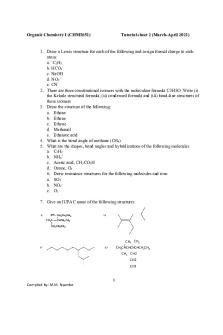Tutorial Sheet 1 PDF

| Title | Tutorial Sheet 1 |
|---|---|
| Author | IVORY HOKE |
| Course | Mechanical Engineering |
| Institution | International University of Malaya-Wales |
| Pages | 2 |
| File Size | 157.2 KB |
| File Type | |
| Total Downloads | 12 |
| Total Views | 140 |
Summary
Download Tutorial Sheet 1 PDF
Description
MEC 2910: Fluid Mechanics Tutorial Sheet - 1 1) Consider the flow of a fluid with viscosity µ through a circular pipe. The velocity profile is shown in the figure, where umax is the maximum velocity, which occurs at the centerline; r is the radial distance from the centerline; u(r) is the flow velocity at any position r. Develop a relation for the drag force exerted on the pipe wall by the fluid in the flow direction per unit length of the pipe. 2) A thin 40-cm X 40-cm flat plate is pulled at 2 m/s horizontally through a 3.6 mm thick oil layer sandwiched between two plates, as shown in the figure. The dynamic viscosity of oil is 0.027 Pa.s. Assuming the velocity profile to be linear, (a) plot the velocity profile and find the location where the oil velocity is zero and (b) determine the force F needed to maintain the motion. 3) The clutch system shown in the figure is used to transmit torque through a 2 mm thick oil film with µ = 0.38 N.s/m2 between two identical 30 cm diameter disks. When the driving shaft rotates at a speed of 1450 rpm, the driven shaft is observed to rotate at 1398 rpm. Determine the transmitted torque.
4) The viscosity of a fluid is to be measured by a viscometer constructed of two 75 cm long concentric cylinders. The outer diameter of the inner cylinder is 15 cm, and the gap between the two cylinders is 1 mm. The inner cylinder is rotated at 300 rpm, and the torque is measured to be 0.8 N.m. Determine the viscosity of the fluid.
5) A thin plate moves between two parallel plates as shown in the figure. The two stationary surfaces are spaced 4 cm apart, and the oil in between them has viscosity 0.9 N.s/m2. The part of the plate immersed in oil at any given time is 2-m long and 0.5 m wide. If the plate moves through the mid-plane between the surfaces, determine the force required to maintain this motion. What would your response be if the plate was 1 cm from the bottom surface (h2) and 3 cm from the top surface (h1)? 6) Consider laminar flow of a Newtonian fluid between two parallel plates as shown in the figure. Develop a relation for the drag force exerted on both plates by the fluid in the flow direction per unit area of the plates.
7) In some damping systems, a circular disk immersed in oil is used as a damper as shown in the figure. Show that the damping torque is proportional to angular speed in accordance with the relation Tdamping = Cω. Find the expression for C neglecting tip effects.
8) Some non-Newtonian fluids behave as a Bingham plastic for which shear stress can be expresses as τ = τy + μ(du/dr). For flow of a Bingham plastic in a horizontal pipe of radius R, the velocity profile is given as u(r) = (ΔP/4μL)(r2-R2) + (τy / μ)(r – R), where ΔP/L is the constant pressure drop along the pipe per unit length and r is the radial distance from the centerline. Determine (a) the wall shear stress and (b) the drag force acting on a pipe section of length L....
Similar Free PDFs

Tutorial sheet 1 Solution
- 5 Pages

Tutorial Sheet 1
- 2 Pages

Tutorial Sheet 1
- 1 Pages

Tutorial Sheet 2-1 - Practise
- 6 Pages

Solution of Tutorial sheet 6
- 12 Pages

Tutorial 1
- 4 Pages

Tutorial 1
- 2 Pages

Tutorial 1
- 21 Pages

Tutorial 1
- 11 Pages

Tutorial 1
- 5 Pages

Tutorial 1
- 2 Pages
Popular Institutions
- Tinajero National High School - Annex
- Politeknik Caltex Riau
- Yokohama City University
- SGT University
- University of Al-Qadisiyah
- Divine Word College of Vigan
- Techniek College Rotterdam
- Universidade de Santiago
- Universiti Teknologi MARA Cawangan Johor Kampus Pasir Gudang
- Poltekkes Kemenkes Yogyakarta
- Baguio City National High School
- Colegio san marcos
- preparatoria uno
- Centro de Bachillerato Tecnológico Industrial y de Servicios No. 107
- Dalian Maritime University
- Quang Trung Secondary School
- Colegio Tecnológico en Informática
- Corporación Regional de Educación Superior
- Grupo CEDVA
- Dar Al Uloom University
- Centro de Estudios Preuniversitarios de la Universidad Nacional de Ingeniería
- 上智大学
- Aakash International School, Nuna Majara
- San Felipe Neri Catholic School
- Kang Chiao International School - New Taipei City
- Misamis Occidental National High School
- Institución Educativa Escuela Normal Juan Ladrilleros
- Kolehiyo ng Pantukan
- Batanes State College
- Instituto Continental
- Sekolah Menengah Kejuruan Kesehatan Kaltara (Tarakan)
- Colegio de La Inmaculada Concepcion - Cebu




